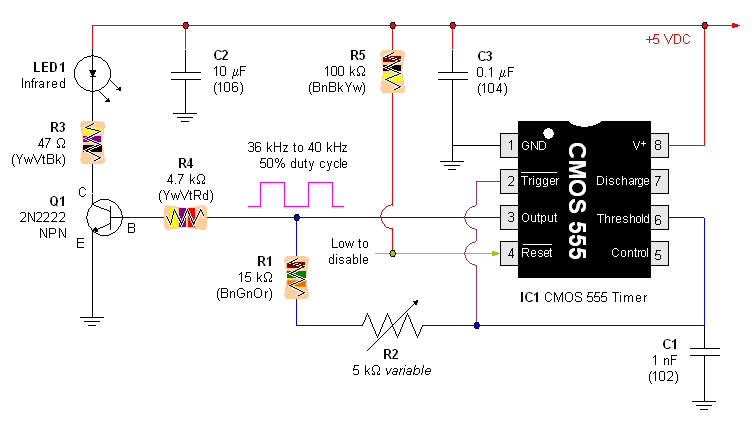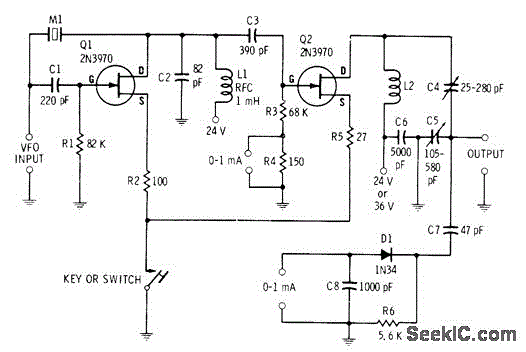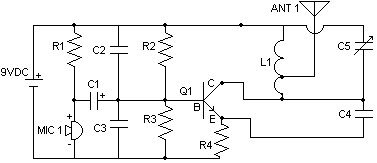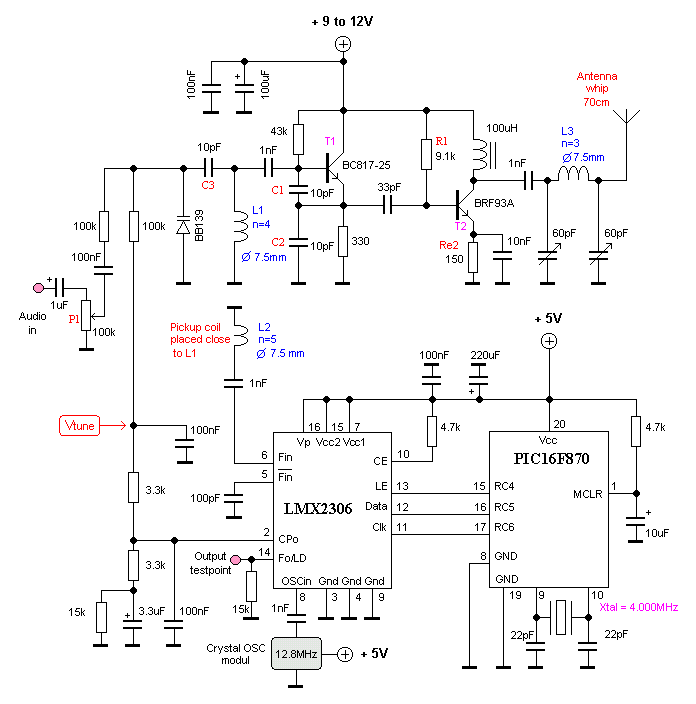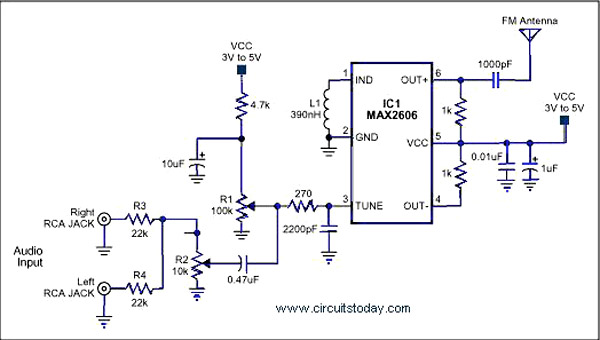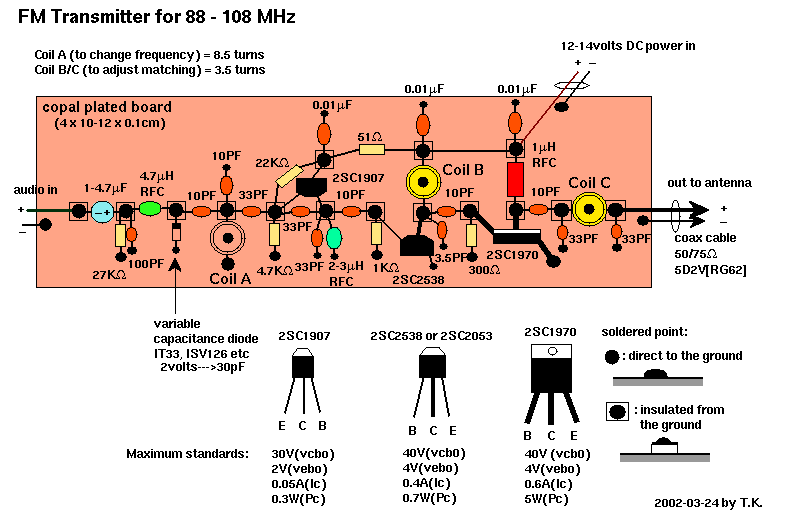
tv transmitter
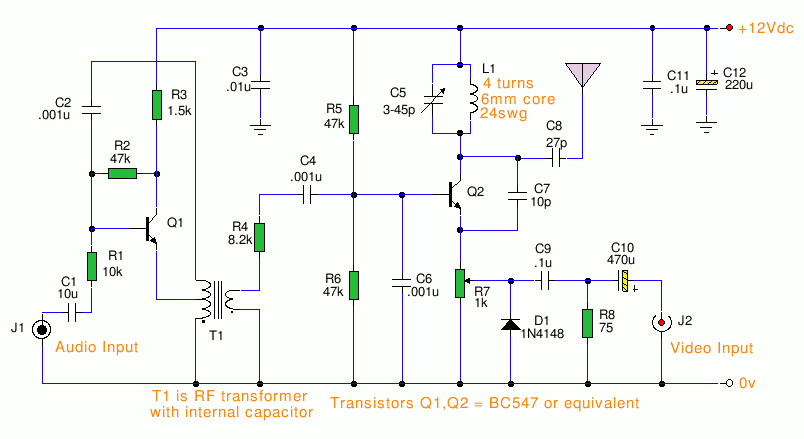
The transmitter operates within the VHF and VLF frequency ranges on TV channels, though it has not been tested for UHF frequencies. The modulated sound signal spans 5.5 to 6 MHz, which can be adjusted by tuning capacitor C5. The modulation method used is frequency modulation (FM), and it is compatible with the UK System I sound standard. The transmitter functions specifically at VHF frequencies between 54 and 216 MHz, making it suitable only for countries that utilize PAL System B and PAL System G.
The described transmitter circuit is designed to operate effectively within the VHF (Very High Frequency) and VLF (Very Low Frequency) ranges, specifically targeting the frequency spectrum used by television broadcasts. The circuit's primary function is to modulate audio signals onto carrier frequencies that fall within the specified range of 54 to 216 MHz. This frequency range is crucial for ensuring compatibility with various television systems, particularly in regions employing the PAL System B and PAL System G formats, which are prevalent in several countries.
The modulation process is achieved through frequency modulation (FM), which is a technique that conveys information over a carrier wave by varying its frequency. This method is particularly advantageous for audio transmission, as it provides improved resistance to noise and interference compared to amplitude modulation (AM). The circuit's ability to tune the frequency of the modulated sound signal between 5.5 and 6 MHz is facilitated by the variable capacitor C5. By adjusting C5, the user can fine-tune the transmitter's output to ensure optimal performance and compliance with local broadcasting regulations.
It is important to note that while the circuit has been validated for VHF and VLF ranges, it has not been tested for UHF (Ultra High Frequency) applications. This limitation may affect its versatility in regions where UHF frequencies are predominantly used for television broadcasting. Overall, the transmitter circuit is a specialized device tailored for specific broadcasting standards and frequency ranges, making it a valuable tool for applications within compatible regions.Notes: The frequency of the transmitter lies within VHF and VLF range on the TV channel, however this circuit has not been tested at UHF frequencies. The modulated sound signal contains 5. 5 -6MHz by tuning C5. Sound modulation is FM and is compatible with UK System I sound. The transmitter however is working at VHF frequencies between 54 and 216MH z and therefore compatible only with countries using Pal System B and Pal System G. 🔗 External reference
The described transmitter circuit is designed to operate effectively within the VHF (Very High Frequency) and VLF (Very Low Frequency) ranges, specifically targeting the frequency spectrum used by television broadcasts. The circuit's primary function is to modulate audio signals onto carrier frequencies that fall within the specified range of 54 to 216 MHz. This frequency range is crucial for ensuring compatibility with various television systems, particularly in regions employing the PAL System B and PAL System G formats, which are prevalent in several countries.
The modulation process is achieved through frequency modulation (FM), which is a technique that conveys information over a carrier wave by varying its frequency. This method is particularly advantageous for audio transmission, as it provides improved resistance to noise and interference compared to amplitude modulation (AM). The circuit's ability to tune the frequency of the modulated sound signal between 5.5 and 6 MHz is facilitated by the variable capacitor C5. By adjusting C5, the user can fine-tune the transmitter's output to ensure optimal performance and compliance with local broadcasting regulations.
It is important to note that while the circuit has been validated for VHF and VLF ranges, it has not been tested for UHF (Ultra High Frequency) applications. This limitation may affect its versatility in regions where UHF frequencies are predominantly used for television broadcasting. Overall, the transmitter circuit is a specialized device tailored for specific broadcasting standards and frequency ranges, making it a valuable tool for applications within compatible regions.Notes: The frequency of the transmitter lies within VHF and VLF range on the TV channel, however this circuit has not been tested at UHF frequencies. The modulated sound signal contains 5. 5 -6MHz by tuning C5. Sound modulation is FM and is compatible with UK System I sound. The transmitter however is working at VHF frequencies between 54 and 216MH z and therefore compatible only with countries using Pal System B and Pal System G. 🔗 External reference
